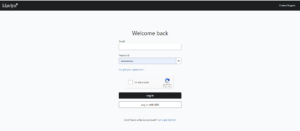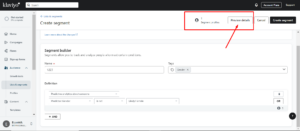How can we create segment on Klaviyo
E-commerce has become a vast space, and it is important to streamline every process to make sure that you stay ahead of your peers. Klaviyo is a powerful email marketing platform that specializes in e-commerce. Creating segment on Klaviyo allows you to target specific groups of subscribers with tailored content.
What is Klaviyo segmentation?
Klaviyo segmentation allows you to create distinct customer groups based on specific criteria, enabling you to send targeted messages that resonate with each segment’s unique needs and interests.
Imagine you run a thriving online sports apparel store. Sending a generic “20% off all sneakers” email blast to your entire email list might not be the most effective approach. A significant portion of your audience might be more interested in jerseys or athletic wear. In this case, segmentation becomes more helpful.
What are the key aspects of Klaviyo segmentation?
- Klaviyo utilizes several customer data collection points to create segments, which include the following:
- Purchase history: Previous purchases contribute to understanding customers’ preferences. A group of clients can be defined as those who have bought training shoes before, and they can then be offered discounts on new sportswear or additional items.
- Browsing behavior: The study of browsing behavior refers to using website tracking tools that can unveil what products or categories a particular customer has been viewing. Hence, you can then send them emails that are more focused on promoting items in line with the things they have searched for.
- Demographics: Demographics are largely understood to be the basis for crafting geographically relevant promotions or emphasizing products that cater to a given age group or location.
- Email engagement: The segmentation of email engagement based on email open rates and click-through rates can help identify highly engaged subscribers, whom you can then reward with exclusive offers or early access to new products.
- Segment Creation: With the help of Klaviyo’s interface, you can build targeted customer groups based on specific criteria. By utilizing multiple data points, you can divide them in a more detailed manner. An example could be “engaged customers in California who have already purchased basketball equipment,” enabling them to receive an email marketing campaign regarding an upcoming basketball clinic or attractive discounts on basketball gear.
What are the benefits of Klaviyo segmentation?
- Increased engagement: The efficiency of the targeted messages is due to the fact that they are more appropriate for your audience. As a result, better open rates, click-through rates, and campaign engagement are achieved.
- Better conversion rates: By taking into account all the needs and interests of your customers, you can offer certain promotions and drive more sales and conversions.
- Enhanced brand loyalty: Enhanced brand loyalty results from personalized communication and creates a sense of bond with your clients by building a connection, which leads to repeat transactions when they feel appreciated and valued.
- Optimized Marketing Spend: Segmentation allows you to focus your marketing efforts on the most receptive segments, maximizing your return on investment (ROI).
How to use Klaviyo segmentation?
- Define Your Segmentation Goals: What are your segmentation objectives? In order to get into the fine details of things, first define your goals. Do you want to increase sales of one product line or re-engage inactive subscribers, or do you want to raise brand awareness? If you have well-defined objectives, it will inform how you segment.
- Identify Segmentation Criteria: How should you select the criteria for segmentation? Look at the purchase histories of your customers, their demography, browsing activities, and engagement with emails among other related factors.
- Build Your Segments: How can you build segments? Klaviyo’s interface is designed in such a way that the creation of targeted customer groups based on your selected criteria is possible. You may use filters and logical operations to come up with exact segments. For example, create this segment called “high-value customers from New York” which includes customers who have spent more than $500 in the past year and live in New York State.
- Craft Personalized Campaigns: What should be done about personalized campaigns? Now that you have established the needed segments it is time to develop focused marketing campaigns. Customize email content, social media posts, or SMS messages that resonate with the specific interests and needs of each segment. Use appropriate product recommendations, emphasize special offers aligned with their preferences, and personalize communication for connecting purposes.
- Track and Analyze Performance: Klaviyo provides comprehensive campaign performance metrics. Monitor open rates, click-through rates, and conversion rates for each segment. Analyze the data to identify which segments are performing well and which ones might require adjustments in your targeting or messaging strategy.
List vs. segmentation
Lists: A Basic Building Block
- Concept: An email list is a fundamental component of e-commerce marketing. It’s essentially a collection of email addresses gathered through various opt-in methods like website signups, subscription forms, or in-store purchases.
- Characteristics: Lists are static in nature. Once someone subscribes, their information remains on the list until they unsubscribe or are manually removed.
- Use Cases: Email lists serve as the foundation for your marketing efforts. They allow you to broadcast announcements, share company updates, or send generic promotional emails to your entire subscriber base.
- Limitations: Generic messages sent to a broad audience often lack personalization, leading to lower engagement and potentially frustrating subscribers who might not be interested in all your offerings.
Segmentation: Targeting with Precision
- Concept: Segmentation takes email marketing a step further. It involves dividing your email list into smaller, more targeted groups based on specific criteria.
- Characteristics: Segments are dynamic. They can be constantly updated as new data becomes available about your subscribers’ behaviour and preferences.
- Use Cases: Segmentation allows you to craft highly personalized and relevant marketing campaigns. You can target specific segments with special offers, product recommendations, or educational content tailored to their interests.
Here’s how you can create a segment in Klaviyo:
1. Log in to Your Klaviyo Account:
Log in to your Klaviyo account dashboard.
2. Navigate to the Lists & Segments Section:
On the left-hand side of the dashboard, you’ll find a menu. Click on “Lists & Segments.”
3. Select the List You Want to Create a Segment for:
- Choose the list that contains the subscribers you want to segment.
4. Create a New Segment:
- In the Lists & Segments section, click on “Segments.”
- Click the “Create Segment” button.
5. Define Segment Criteria:
- Give your segment a name to identify it.
- Define the criteria for your segment.
- Klaviyo offers a wide range of options to segment based on attributes, behaviors, and more.
You can segment based on factors such as purchase history, engagement behavior, location, custom properties, and more.
6. Preview and Save the Segment:
- After setting up the segment criteria, you can preview the segment to see a list of subscribers who meet the conditions.
- Click the “Preview” button to see a sample of subscribers in the segment.
If everything looks good, click the “Save Segment” button.
7. Use the Segment in Campaigns:
Once you’ve created the segment, you can use it when setting up your email campaigns.
Klaviyo makes it easy to select the segment you want to target with each campaign.
Please note that software interfaces and features can change over time. If you’re using a more recent version of Klaviyo, there might be slight differences in the steps or interface. For the most accurate and up-to-date instructions, I recommend referring to Klaviyo’s official documentation or help resources.













